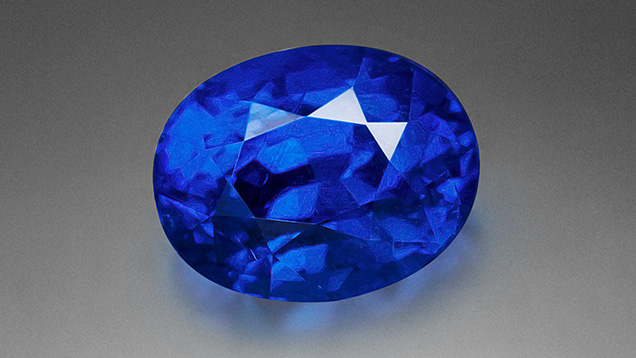A “Cobalt Blue” Gahnospinel

GIA’s Bangkok laboratory recently examined an intense blue 1.01 ct transparent oval mixed cut (figure 1). Standard gemological testing revealed a refractive index of 1.742 and a hydrostatic specific gravity of 3.96. The stone was inert to long-wave and short-wave UV light. Microscopic observation revealed dense intersecting needles, iridescent thin films, particulate clouds, and flaky whitish inclusions. Laser ablation–inductively coupled plasma–mass spectrometry (LA-ICP-MS) was used to obtain oxide weight percentages (wt.% oxides) of aluminum, iron, magnesium, and zinc to calculate the chemical formula of the stone. It was determined to be (Mg0.64Fe2+0.02Zn0.34)Al2O4. All of these properties were consistent with gahnospinel, which is a zinc-rich variety of the spinel group. Its chemical properties result from zinc substituting for magnesium in a solid solution series with end members gahnite (ZnAl2O4) and spinel (MgAl2O4).

Interestingly, gahnospinel is usually found with a more muted dark blue to dark greenish blue color, but this intense blue specimen contained cobalt as the primary coloring agent, similar to “cobalt blue” gem spinel. Ultraviolet/visible (UV-Vis) spectroscopy showed significant amounts of absorption attributable to cobalt at approximately 550, 593, and 622 nm (figure 2), with additional contribution from iron at approximately 456, 550, and 593 nm (G.B. Andreozzi et al., “Color mechanism in spinel: A multi-analytical investigation of natural crystals with a wide range of coloration,” Physics and Chemistry of Minerals, Vol. 46, 2019, pp. 343–360; V. D’Ippolito et al., “Color mechanism in spinel: Cobalt and iron interplay for the blue color,” Physics and Chemistry of Minerals, Vol. 42, 2015, pp. 431–439). The significant amount of cobalt (198–224 ppmw) from LA-ICP-MS data and the reddish Chelsea filter reaction provided strong evidence that the intense blue color was induced by cobalt. While blue cobalt spinel and gahnite have been previously reported (see J.E. Shigley and C.M. Stockton, “‘Cobalt-blue’ gem spinels,” Spring 1984 G&G, pp. 34–41; T. Stephan et al., “On the colour mechanism of blue gahnite from Nigeria,” Journal of Gems & Gemmology, Vol. 38, No. 2, 2022, pp. 183–193), to our knowledge this is the first report of blue gahnospinel predominantly colored by cobalt.
.jpg)


